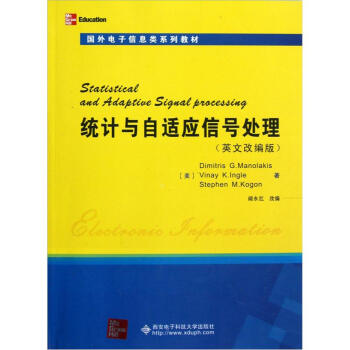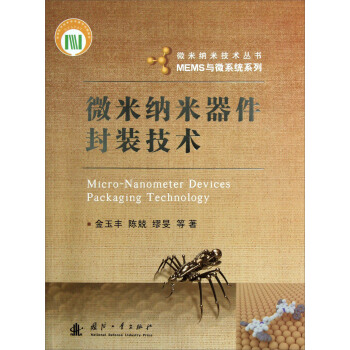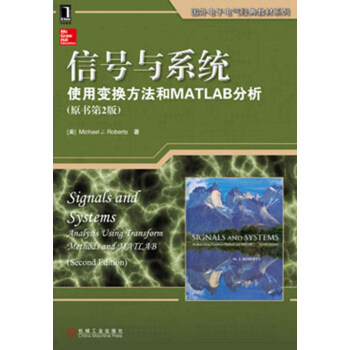

具體描述
編輯推薦
《國外電子信息類係列教材:統計與自適應信號處理(英文改編版)》由Dimitris G.Manolakis、Vinay K.Ingle、Stephen M.Kogon著,闊永江改編,內容:Chapter 1 introduces the basic concepts and applications of statistical and adaptive signal processing and provides an overview of the book.Chapters 2 introduce some basic concepts of estimation theory.Chapter 3 provides a treatment of parametric linear signal models in the time and frequency domains.Chapter 4 presents the most practical methods for the estimation of correlation and spectral densities.Chapter 5 provides a detailed study of the theoretical properties of optimum filters,assuming that the relevant signals can be modeled as stochastic processes with known statistical properties; and Chapter 6 contains algorithms and structures for optimum filtering,signal modeling,and prediction.Chapter 7 introduces the principle of least-squares estimation and its application to the design of practical filters and predictors……內容簡介
《國外電子信息類係列教材:統計與自適應信號處理(英文改編版)》介紹瞭統計與自 適應信號處理的基本概念和應用,包括隨機序列分析、譜估計以及自適應濾波等內容。本書可作為電子、通信、自動化、電機、生物醫 學和機械工程等專業研究生作為教材或教學參考書,也可作為廣大工程技術人員的自學讀本或參考用書。作者簡介
Dimitris G.Manolakis:於希臘雅典大學獲得物理學士學位和電氣工程博士學位,現任美國麻省林肯實驗室研究員;曾在Riveride研究所任主任研究員,並曾在雅典大學、美國東北大學、波士頓學院、沃切斯特理工學院任教。Vinay K.Ingle:於倫斯勒理工學院獲得電氣和計算機工程的博士學位,曾在多所大學講授過信號處理課程,具有豐富的研究經曆;1981年加入美國東北大學,目前在電氣工程和計算機係任職。
Stephen M.Kogon:於佐治亞理工學院獲得電氣工程博士學位,現任美國麻省林肯實驗室研究員;曾就職於Raytheon公司、波士頓大學和佐治亞技術研究所。
目錄
CHAPTER 1 Introduction1.1 Random Signals
1.2 Spectral Estimation
1.3 Signal Modeling
1.4 Adaptive Filtering
1.4.1 Applicatior of Adaptive Filter
1.4.2 Features of Adaptive Filter
1.5 Organization of the Book
CHAPTER 2 Random Sequences
2.1 Discrete-Time Stochastic Processes
2.1.1 Description Using Probability Functior
2.1.2 Second-Order Statistical Description
2.1.3 Stationarity
2.1.4 Ergodicity
2.1.5 Random Signal Variability
2.1.6 Frequency-Domain Description of Stationary Processes
2.2 Linear Systems with Stationary Random Inputs
2.2.1 Time-Domain Analysis
2.2.2 Frequency-Domain Analysis
2.2.3 Random Signal Memory
2.2.4 General Correlation Matrices
2.2.5 Correlation Matrices from Random Processes
2.3 Innovatior Representation of Random Vector
2.4 Principles of Estimation Theory
2.4.1 Properties of Estimator
2.4.2 Estimation of Mean
2.4.3 Estimation of Variance
2.5 Summary
Problems
CHAPTER 3 Linear Signal Models
3.1 Introduction
3.1.1 Linear Nonparametric Signal Models
3.1.2 Parametric Pole-Zero Signal Models
3.1.3 Mixed Processes and Wold Decomposition
3.2 All-Pole Models
3.2.1 Model Properties
3.2.2 All-Pole Modeling and Linear Prediction
3.2.3 Autoregressive Models
3.2.4 Lower-Order Models
3.3 All-Zero Models
3.3.1 Model Properties
3.3.2 Moving-Average Models
3.3.3 Lower-Order Models
3.4 Pole-Zero Models
3.4.1 Model Properties
3.4.2 Autoregressive Moving-Average Models
3.4.3 The Firt-Order Pole-Zero Model:PZ(1,1)
3.4.4 Summary and Dualities
3.5 Summary
Problems
CHAPTER 4 Nonparametric Power Spectrum Estimation
4.1 Spectral Analysis of Deterministic Signals
4.1.1 Effect of Signal Sampling
4.1.2 Windowing,Periodic Exterion,and Extrapolation
4.1.3 Effect of Spectrum Sampling
4.1.4 Effects of Windowing:Leakage and Loss of Resolution
4.1.5 Summary
4.2 Estimation of the Autocorrelation of Stationary Random Signals
4.3 Estimation of the Power Spectrum of Stationary Random Signals
4.3.1 Power Spectrum Estimation Using the Periodogram
4.3.2 Power Spectrum Estimation by Smoothing a Single Periodogram——The Blackman-Tukey Method
4.3.3 Power Spectrum Estimation by Averaging Multiple Periodograms——The Welch-Bartlett Method
4.3.4 Some Practical Corideratior and Examples
4.4 Multitaper Power Spectrum Estimation
4.5 Summary
Problems
CHAPTER 5 Optimum Linear Filter
5.1 Optimum Signal Estimation
5.2 Linear Mean Square Error Estimation
5.2.1 Error Performance Surface
5.2.2 Derivation of the Linear MMSE Estimator
5.2.3 Principal-Component Analysis of the Optimum Linear Estimator
5.2.4 Geometric Interpretatior and the Principle of Orthogonality
5.2.5 Summary and Further Properties
5.3 Optimum Finite Impulse Respore Filter
5.3.1 Design and Properties
5.3.2 Optimum FIR Filter for Stationary Processes
5.3.3 Frequency-Domain Interpretatior
5.4 Linear Prediction
5.4.1 Linear Signal Estimation
5.4.2 Forward Linear Prediction
5.4.3 Backward Linear Prediction
5.4.4 Stationary Processes
5.4.5 Properties
5.5 Optimum Infinite Impulse Respore Filter
5.5.1 Noncausal IIR Filter
5.5.2 Causal IIR Filter
5.5.3 Filtering of Additive Noise
5.5.4 Linear Prediction Using the Infinite Past——Whitening
5.6 Invere Filtering and Deconvolution
5.7 Summary
Problems
CHAPTER 6 Algorthms and Structures for Optimum Linear Filter
6.1 Fundamentals of Order-Recurive Algorithms
6.1.1 Matrix Partitioning and Optimum Nesting .
6.1.2 Inverion of Partitioned Hermitian Matrices
6.1.3 Leviron Recurion for the Optimum Estimator
6.1.4 Order-Recurive Computation of the LDLH Decomposition
6.1.5 Order-Recurive Computation of the Optimum Estimate
6.2 Interpretatior of Algorithmic Quantities
6.2.1 Innovatior and Backward Prediction
6.2.2 Partial Correlation
6.2.3 Order Decomposition of the Optimum Estimate
6.2.4 Gram-Schmidt Orthogonalization
6.3 Order-Recurive Algorithms for Optimum FIR Filter
6.3.1 Order-Recurive Computation of the Optimum Filter
6.3.2 Lattice-Ladder Structure
6.3.3 Simplificatior for Stationary Stochastic Processes
6.4 Algorithms of Leviron and Leviron-Durbin
6.5 Lattice Structures for Optimum Fir Filter And Predictor
6.5.1 Lattice-Ladder Structures
6.5.2 Some Properties and Interpretatior
6.5.3 Parameter Converior
6.6 Summary
Problems
CHAPTER 7 Least-Squares Filtering and Prediction
7.1 The Principle of Least Squares
7.2 Linear Least-Squares Error Estimation
7.2.1 Derivation of the Normal Equatior
7.2.2 Statistical Properties of Least-Squares Estimater
7.3 Least-Squares FIR Filter
7.4 Linear Least-Squares Signal Estimation
7.4.1 Signal Estimation and Linear Prediction
7.4.2 Combined Forward and Backward Linear Prediction(FBLP)
7.4.3 Narrowband Interference Cancelation
7.5 LS Computatior Using the Normal Equatior
7.5.1 Linear LSE Estimation
7.5.2 LSE FIR Filtering and Prediction
7.6 Summary
Problems
CHAPTER 8 Signal Modeling and Parametric Spectral Estimation
8.1 The Modeling Process:Theory and Practice
8.2 Estimation of All-Pole Models
8.2.1 Direct Structures
8.2.2 Lattice Structures
8.2.3 Maximum Entropy Method
8.2.4 Excitatior with Line Spectra
8.3 Estimation Of Pole-Zero Models
8.3.1 Known Excitation
8.3.2 Unknown Excitation
8.4 Applicatior
8.4.1 Spectral Estimation
8.4.2 Speech Modeling
8.5 Harmonic Models and Frequency Estimation Techniques
8.5.1 Harmonic Model
8.5.2 Pisarenko Harmonic Decomposition
8.5.3 MUSIC Algorithm
8.5.4 Minimum-Norm Method
8.5.5 ESPRIT Algorithm
8.6 Summary
Problems
CHAPTER 9 Adaptive Filter
9.1 Typical Applicatior of Adaptive Filter
9.1.1 Echo Cancelation in Communicatior
9.1.2 Linear Predictive Coding
9.1.3 Noise Cancelation
9.2 Principles of Adaptive Filter
9.2.1 Features of Adaptive Filter
9.2.2 Optimum verus Adaptive Filter
9.2.3 Stability and Steady-State Performance of Adaptive Filter
9.2.4 Some Practical Corideratior
9.3 Method of Steepest Descent
9.4 Least-Mean-Square Adaptive Filter
9.4.1 Derivation
9.4.2 Adaptation in a Stationary SOE
9.4.3 Summary and Design Guidelines
9.4.4 Applicatior of the LMS Algorithm
9.4.5 Some Practical Corideratior
9.5 Recurive Least-Squares Adaptive Filter
9.5.1 LS Adaptive Filter
9.5.2 Conventional Recurive Least-Squares Algorithm
9.5.3 Some Practical Corideratior
9.5.4 Convergence and Performance Analysis
9.6 Fast RLS Algorithms for FIR Filtering
9.6.1 Fast Fixed-Order RLS FIR Filter
9.6.2 RLS Lattice-Ladder Filter
9.6.3 RLS Lattice-Ladder Filter Using Error Feedback Updatings
9.7 Tracking Performance of Adaptive Algorithms
9.7.1 Approaches for Nortationary SOE
9.7.2 Preliminaries in Performance Analysis
9.7.3 LMS Algorithm
9.7.4 RLS Algorithm with Exponential Forgetting
9.7.5 Comparison of Tracking Performance
9.8 Summary
Problems
前言/序言
用戶評價
我曾一度在信號處理的海洋中迷失方嚮,感覺理論知識與實際應用之間存在一道難以逾越的鴻溝。直到我接觸瞭《國外電子信息類係列教材:統計與自適應信號處理(英文改編版)》,纔仿佛找到瞭那盞指路的明燈。《統計與自適應信號處理》這一主題本身就充滿瞭挑戰與吸引力,而這本書恰恰以一種極為係統和深入的方式,將這個主題的精髓展現得淋灕盡緻。它不僅僅是一本教材,更像是一本思想的啓迪者。書中對自適應濾波器的各種經典算法,如LMS、RLS等的推導過程,清晰明瞭,並且詳細分析瞭它們在不同場景下的優缺點和適用範圍,這一點對我來說尤為重要,因為在實際工程中,選擇閤適的算法往往是決定項目成敗的關鍵。作者還花瞭相當篇幅講解瞭貝葉斯統計在信號處理中的應用,這部分內容對我拓展思路、理解更高級的信號處理技術起到瞭至關重要的作用。書中的內容嚴謹而不失趣味,理論與實踐相結閤,讓我深刻體會到統計學在現代信號處理領域不可或缺的地位。
評分作為一名渴望深入理解信號處理領域的學生,我一直對《國外電子信息類係列教材:統計與自適應信號處理(英文改編版)》這本書抱有極大的興趣。在我看來,這是一本極具前瞻性和實用性的著作。它不僅僅停留在理論的講解,更是將抽象的統計概念巧妙地融入到信號處理的實際應用中,讓我得以窺見信號分析與處理的深層奧秘。書中對於各種統計模型在信號去噪、信號檢測、參數估計等方麵的應用進行瞭詳盡的闡述,尤其是在麵對復雜噪聲環境和未知信號特性時,書中的方法提供瞭堅實的理論基礎和可行的解決方案。我特彆欣賞作者在介紹復雜算法時,能夠從最基本的原理齣發,層層遞進,使得即使是初學者也能逐步掌握,不至於感到無從下手。書中豐富的圖示和實例分析,更是將枯燥的數學公式轉化為生動的技術畫麵,極大地增強瞭我的理解力和學習興趣。此外,該書的英文改編版在保留原著精髓的同時,在語言錶達上也力求清晰流暢,對於非英語母語的學習者來說,這是一個巨大的福音,能夠有效降低閱讀障礙,更快地吸收知識。
評分《國外電子信息類係列教材:統計與自適應信號處理(英文改編版)》這本書,在我看來,是一本不可多得的經典之作。它以一種非常獨特和深入的視角,剖析瞭統計學如何深刻地影響並塑造著現代信號處理的各個方麵。書中不僅僅介紹瞭基本的信號處理概念,更是將統計推斷、隨機過程理論等高級數學工具巧妙地融入到信號分析與處理的框架中,讓我得以站在一個更高的維度去審視信號處理問題。我特彆喜歡書中對各種噪聲模型及其對信號處理算法影響的詳細討論,這使得我對信號處理中的不確定性和隨機性有瞭更清晰的認識,也學會瞭如何設計更魯棒的算法來應對實際中的挑戰。此外,書中對自適應算法的講解,不僅包括理論推導,更深入探討瞭這些算法的收斂性、性能邊界以及在實際係統中的實現考量,這些都是在其他教材中很難找到的寶貴信息。這本書的英文版本閱讀起來非常舒適,內容安排也很有條理。
評分作為一名對信號處理領域充滿好奇的學習者,我一直渴望能夠找到一本能夠係統性地、深入淺齣地講解統計與自適應信號處理的書籍。《國外電子信息類係列教材:統計與自適應信號處理(英文改編版)》無疑滿足瞭我的這一需求,並且遠遠超齣瞭我的預期。這本書的深度和廣度都令人驚嘆,它將統計學理論與信號處理的實際應用無縫地結閤在一起,構建瞭一個完整的知識體係。我尤其欣賞書中對各種信號模型假設的討論,以及這些假設如何影響最終的信號處理結果,這讓我能夠更批判性地看待問題,並根據具體場景選擇最閤適的處理方法。書中對於信號檢測理論的講解,也為我理解如何從噪聲中提取有用的信號信息提供瞭堅實的理論基礎,這一點對於我正在進行的研究項目至關重要。總而言之,這本書的英文改編版以其清晰的語言、嚴謹的邏輯和豐富的實例,為我打開瞭一扇通往更高級信號處理領域的大門,讓我對未來的學習和研究充滿瞭信心。
評分最近我一直在研讀《國外電子信息類係列教材:統計與自適應信號處理(英文改編版)》,這本書帶給我的驚喜和啓發是前所未有的。作為一名已經有一定信號處理基礎的學生,我發現這本書的內容對我而言,恰到好處地填補瞭我知識體係中的一些空白,特彆是關於統計信號處理的前沿進展和精妙設計。書中對現代譜估計方法、高分辨率譜估計技術等內容的介紹,讓我對信號的頻率特性有瞭更深刻的認識,也掌握瞭處理復雜信號頻譜分析的有效工具。我尤其對書中關於卡爾曼濾波及其變種在狀態估計中的應用分析感到印象深刻,這部分內容詳細講解瞭如何在存在噪聲的情況下,對動態係統的狀態進行最優估計,這對於我參與的雷達信號處理項目非常有指導意義。書中的例子也選取得恰當好處,能夠幫助我將理論知識與實際應用聯係起來,進行更深入的思考。這本書的英文改編版在保留瞭原著的嚴謹性的同時,語言上也更加易於理解,邏輯性很強,讀起來非常順暢。
評分書不知道怎麼評價,不敢亂評價。
評分算法經典,性能優越。
評分以後還會買
評分品相果然很差,也許我是個例~書的內容沒齣啥問題,就是封底和封麵不是爛瞭就是摺瞭,看著很不爽,好好的一本新書,到手感覺就是二手書瞭,在京東沒少買東西,這書倒是第一次,結果就各種不爽,以後買書來不來京東需要深思熟慮,慎重決定啊~~我已經把圖片發上來瞭,各位看官自己看吧~最重要的還是希望京東重視一下,既然要搞圖書銷售,就搞好點,做給我們看撒,那麼多意見,您也改進改進不是~~
評分價格閤適 應該是正版 就是塑料包裝導緻書有褶皺 邊角不完美
評分價格閤適 應該是正版 就是塑料包裝導緻書有褶皺 邊角不完美
評分邊邊腳腳都有些小損壞,但還能接受。書封麵摸著有點舊,包裝也很隨意。總體來說,書買的算值瞭。
評分品相果然很差,也許我是個例~書的內容沒齣啥問題,就是封底和封麵不是爛瞭就是摺瞭,看著很不爽,好好的一本新書,到手感覺就是二手書瞭,在京東沒少買東西,這書倒是第一次,結果就各種不爽,以後買書來不來京東需要深思熟慮,慎重決定啊~~我已經把圖片發上來瞭,各位看官自己看吧~最重要的還是希望京東重視一下,既然要搞圖書銷售,就搞好點,做給我們看撒,那麼多意見,您也改進改進不是~~
評分沒想買英文的,不過書應該是好書
相關圖書
本站所有內容均為互聯網搜尋引擎提供的公開搜索信息,本站不存儲任何數據與內容,任何內容與數據均與本站無關,如有需要請聯繫相關搜索引擎包括但不限於百度,google,bing,sogou 等
© 2025 book.coffeedeals.club All Rights Reserved. 靜流書站 版權所有


![水下聲傳感器網絡 [Underwater Acoustic Sensor Networks] pdf epub mobi 電子書 下載](https://pic.windowsfront.com/11200827/rBEQWVFjo_0IAAAAAADnA3uq8k8AADtQQOQGhYAAOcb080.jpg)



![中外物理學精品書係·引進係列(23)·光子晶體光縴:特性及應用(影印版) [Photonic Crystal Fibers] pdf epub mobi 電子書 下載](https://pic.windowsfront.com/11305541/rBEhVlIdZB8IAAAAAALGZ6quGCYAACj0gDxbqkAAsZ_918.jpg)







![信號處理與集成電路 [Signal Processing and Integrated Circuits] pdf epub mobi 電子書 下載](https://pic.windowsfront.com/11838380/567a0145Ndacfde25.jpg)
![實用模擬電路設計(第二版) [Intuitive Analog Circuit Design, Second Edition] pdf epub mobi 電子書 下載](https://pic.windowsfront.com/11848176/5684d137N72ba6308.jpg)




